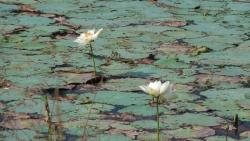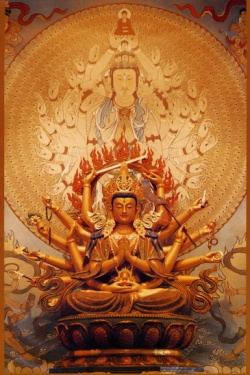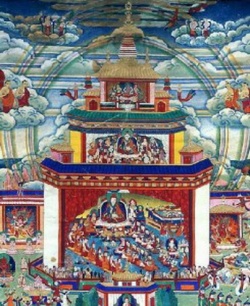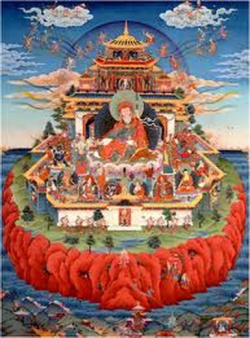A Journey to Tibet's Lost Paradise
IN A HISTORY OF EXPLORATION along the Tibetan frontier, a British field officer wrote of the futile quest for the Falls of the Tsangpo, a colossal waterfall long dreamed of by Victorian geographers. The author invoked a menacing deity that appears to pilgrims from behind a veil of water at the entrance to Tibet's Tsangpo gorge. This shape-shifting cascade, the author wrote, had lured generations of explorers into a quixotic-and often fatal-search for a numinous waterfall in the depths of the earth's deepest chasm. As the author concluded, Shinje Chogyal-the Lord of Death-"had not yet finished his sport with those disposed to listen to his siren-song:' Had they been listening, he maintained, "they might have heard . . . demon laughter borne to them on the wind:" This book is a tribute to that ambiguous laughter, an exploration of the forces, internal and external, that led me and others to attend to the hidden voices of the Tsangpo gorge; the perennial call of unknown, secret places.
From ill-fated forays in the early nineteenth century through a final gambit in 1924, British explorers sought doggedly for a "spectacular cataract" to account for the tremendous drop in altitude from where the Tsangpo- one of Asia's greatest and least known rivers-disappeared into impenetrable chasm in Tibet and where it reemerged 51,ooo feet lower as the Brahmaputra in the jungles of Assam. Lured by the prospect of a geographical grail to claim for their expanding empire, turn-of-the-century explorers envisioned the fabled Falls of the Tsangpo as a rival to Victoria Falls, a symbol of imperial power in the deepest heart of Africa.
Long before the legendary waterfall was even imagined, Tibetans followed mystical prophecies into the labyrinth of the Tsangpo gorge-three times the depth of the Grand Canyon-in search of the heart of an earthly paradise called Beyul Pemako, the Secret Land Shaped Like a Lotus.
FROM APRIL 1994 TO NOVEMBFR 1998 I made eight journeys into the mist-wreathed gorges of the Tsangpo, following the accounts of early British explorers as well as the visionary narratives of Tibetan lamas who had entered the region centuries earlier. This book chronicles my first and last expeditions as well as a pilgrimage in August 1995 to a mountain thought to conceal the key to Pemako's still undiscovered sanctum sanctorum. As I navigated between wild topography and dizzying myth, each journey opened the door to the next and revealed realms beyond the coordinates of conventional geography. Through historical digressions and extensive endnotes, I have tried to place in context the experiences that ultimately led me and my companions to the lost Falls of the Tsangpo, a place historians of exploration had previously dismissed as a "romance of geography" and "one of the most obsessive wild goose chases of modern times."
Tibetans still search the Tsangpo gorges for the elusive sanctuary that their texts describe as "a celestial realm on earth:' The Falls of the Tsangpo, one of several portals into this mysterious domain, was not a goal in itselfi but a place of passage, a doorway-whether literal or figurative-to a hidden realm of mind and spirit. For the pilgrim, Pemako's elusive center is not some lost and unattainable Eden, but an immanent paradise veiled more by habits of perception than by features of the landscape.
Lying along a suture between continents that collided more than forty million years ago, Pemako is far more than a source of the legend of Shangri-La.
The Tsangpo gorges present an ecosystem of astounding diversity, from ice falls and subtropical jungles to rare medicinal plants. Like the visionary scrolls that urge Tibetan pilgrims into this bountiful terrain, Pemako's orchid- drenched cloud forests and moss-covered cliffs offer doorways into spaces of mysterious promise, to a world unfallen, where some of the deepest dreams of the earth and our species are still vibrantly alive.
As I followed the accounts of Tibetan pilgrims, as well as those of Victorian and Edwardian explorers, Pemako became for me a realm of unbounded possibility, a place where geographical exploration merged with discoveries of the spirit. This book celebrates those who have journeyed into the gorges, not to extract trophies or make dubious claims, hut in the deepest spirit of adventure, attentive to the hidden voices of this mythic world. In 1925 the intrepid plant collector Frank Kingdon Ward wrote of his own journey that: "I am fully conscious that a complete presentation of the regions visited is a task beyond my power. All I can strive to do is convey an illusion-my own illusion, if you like-which nothing short of a visit to the great gorge of the Tsangpo can dispel."
Introduction
Centuries ago, texts were discovered in Tibet describing beyul, hidden-lands where the essence of the Buddhist Tantras is said to be preserved for future generations. These revered scriptures are attributed to Padmasambhava, the eighth- century Buddhist adept celebrated as Guru Rinpoche~, who helped to establish Buddhism in Tibet. They describe valleys reminiscent of paradise that can only be reached with enormous hardship. Pilgrims who travel to these wild and distant places often recount extraordinary experiences similar to those encountered by spiritual practitioners on the Buddhist path to Liberation.
One of the most renowned of these hidden-lands lies in the region of the Tsangpo gorges in southeastern Tibet. It is called Beyul Pemako, "the hidden land shaped like a lotus." Many pilgrims have journeyed there in search of its innermost sanctuary. From a Buddhist perspective, sacred environments such as Pemako are not places to escape the world, but to enter it more deeply. The qualities inherent in such places reveal the interconnectedness of all life and deepen awareness of hidden regions of the mind and spirit. Visiting such places with a good motivation and appropriate merit, the pilgrim can learn to see the world differently from the way it commonly appears, developing and enhancing the Buddhist virtues of wisdom and compassion.
Whether this mysterious sanctuary hidden amid Pemako's mist-shrouded mountains can ever be located geographically is of secondary importance to the journey itself. In the Buddhist tradition, the goal of pilgrimage is not so much to reach a particular destination as to awaken within oneself the qualities and energies of the sacred site, which ultimately lie within our own minds.
Ian Baker has made repeated journeys into Pemako, following the accounts of Tibetan texts describing these places of pilgrimage. These works reveal the Tsangpo gorge as the life-current of the female deity Vajravarahi (Tibetan: Dorje Pagmo,), whose form is identified with Pemako's inner topography. In the deepest part of the gorge he descended to a waterfall that British explorers had sought for more than a century. Some Tibetans maintain that these falls are an entrance to Pemako's hidden center. Whether this waterfall is literally the gateway to Yang- sang, as legend maintains, I cannot say, but waterfalls serve an important role in Buddhist practice as symbols of impermanence and supports for certain kinds of meditation. Such places often have a power that we cannot easily describe or explain. When approached with an awareness of the emptiness and luminosity underlying all appearances, they can encourage us to expand our vision not only of ourselves, but of reality itself I hope that Ian Baker's book about his journeys into one of the least explored regions of Tibet will inspire others not only to venture into unknown lands on a geographical level but also to discover the inner realms within which our own deepest nature lies hidden.



